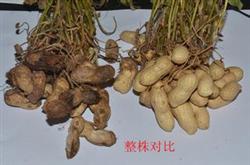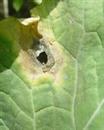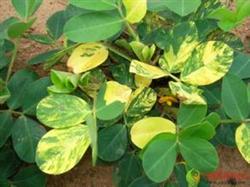Double improvement of yield and quality in comprehensive prevention of peanut fruit rot

Peanut fruit rot is also known as "peanut rot disease". In recent years, the disease is more common in the main peanut producing areas in our province, such as Daming, Xinle, Dingzhou, Xingtang, Luan County and so on, especially when Rain Water is encountered in the podding period of continuous cropping for many years. The disease will be more serious. According to the survey, if the infected land is light, the production will be reduced by 20%, and the serious one will be reduced by more than 50%. The disease has become a major disease in peanut production, which poses a very serious threat to the yield and quality of peanuts. In production, the occurrence of this disease is relatively common, and it is difficult to control. Comprehensive control should be taken in a variety of ways to improve the yield and quality, and then improve the planting efficiency. 1. Etiological analysis: peanut fruit rot is mainly manifested in peanut rot, the light half of the pod is brown or black, the kernel inside is small and hard, dysplastic, the pericarp is yellow, the serious whole pod is dark black, and the pericarp and kernels are rotten. Generally, the whole plant or spot occurs. It is possible for peanuts to fall ill from the podding period in July to the harvest period. There are many causes of peanut rot, especially Fusarium oxysporum, soil-borne bacteria, soil lack of calcium, grubs and other underground pests. Second, prevention and control methods 1. Crop rotation. According to the investigation, most of the spring peanuts planted in the main peanut producing areas of our province are sandy beaches along the banks of the river, and this kind of land is the most suitable for planting peanuts, so the phenomenon of peanut continuous cropping is very serious. Due to continuous cropping, the accumulation of harmful bacteria in the soil increases year by year, and some toxic substances are secreted by peanut roots, coupled with farmers' increasing dependence on chemical fertilizer, resulting in a high degree of salinization of the soil. Peanut growth of the soil environment is obviously deteriorated, so the quality of peanut seedlings is not high, it is easy to induce fruit rot. In order to reduce the incidence of the disease, scientific crop rotation should be achieved and replanted after an interval of two to three years. two。 Change species in different places. Peanut itself is a kind of conventional species for production, some farmers do not have the consciousness of superior varieties and the concept of changing varieties, and hold an old variety for three, five or even eight or ten years, and do not pay attention to the selection and rejuvenation of the varieties in the process of production. as a result, the variety has serious species degradation, poor quality, decreased yield and increased susceptibility, especially to the fruit rot of soil-borne diseases. For this reason, the method of changing seeds in different places can not only reduce the occurrence of diseases, but also increase the yield of peanut to the maximum extent. For example, growers in Hebei should buy peanut seeds bred in Shandong, Henan and other places. According to the investigation of production experiments, changing peanuts in other places can increase the yield by 15% to 30%. 3. Balanced fertilization. Peanut is a kind of economic crop which needs a lot of fertilizer, especially for phosphate and potash fertilizer. in addition, the application of trace fertilizers such as calcium, sulfur, zinc, manganese, molybdenum and boron can obviously improve the yield and quality of peanut and reduce the incidence of diseases. For the beach land with poor soil fertility, it is necessary to increase the application of livestock and poultry manure, such as ring manure, barnyard manure, chicken manure and so on. The combination of urea, phosphate fertilizer and potash fertilizer can be selected in accordance with the principle of economic benefit. After peanut entered the podding stage, topdressing nitrogen, potassium, or compound fertilizer twice, foliar fertilization in the later stage could significantly reduce the occurrence of diseases and increase peanut yield. In addition, adding an appropriate amount of biological fertilizer to the base fertilizer can greatly increase the content of beneficial bacteria in the soil, reduce the content of harmful bacteria, and have an obvious effect on preventing the occurrence of fruit rot. 4. Mix seeds with potions. The results showed that the seed dressing treatment with fungicides and pesticides before sowing could effectively reduce the incidence of diseases and insect pests and had a significant effect on the prevention of fruit rot. Can choose happy time, Gao Qiao, carbendazim and so on. 5. Prevent diseases and insects as soon as possible. Once peanut is infected with fatal diseases such as root rot and stem rot, it will also cause the occurrence of fruit rot. Grubs, golden needles, ground tigers and other underground pests bite pods, pods will leave wounds, the wound is easy to infect bacteria, especially a large number of Fusarium oxysporum in the soil will easily spread, resulting in the occurrence of fruit rot. To this end, scientific prevention, early prevention and control of diseases and insect pests, prevention and control.
- Prev

Opinions on the occurrence and control of Sclerotinia sclerotiorum in rape
The growth period of rape this year is earlier than that of last year, and its growth is close to that of last year. The incidence characteristics of Sclerotinia sclerotiorum in rape this year are different from those in previous years. According to the comprehensive analysis of many factors, such as the source of bacteria in the field, the growth of rape, the disease resistance of varieties and the climatic conditions of susceptible growth period, the degree of natural occurrence is moderately prevalent. ...
- Next

How to prevent and cure peanut virus disease
Flower disease, one of the main diseases of peanut, seriously affects the yield and quality of peanut, especially in the northern production areas of our country. Peanut virus disease, except bud blight mainly transmitted by thrips, other diseases such as light mottle disease, yellow mosaic disease and common mosaic disease are transmitted through seeds and aphids.
Related
- The first cup of black tea in spring, the flavor and history of tea gardens in Kenya, Africa
- The computer can not only choose potatoes, but also grow tea rice. AI will grow winter oolong tea champion.
- It is not only the inflated tea bitten by insects, but also engraved with the four seasons tea in Beipu.
- The Oriental Beauty Tea Festival in Zhuxian County takes the stage at the weekend to experience the plus-size feast of oil tea.
- & quot; Oriental Beauty Tea & Exploration of Emei in Hsinchu, the hometown of quot;
- The new variety of strawberry "Tainong 1" dessert is the first choice with mellow aroma. Crimson gorgeous
- History of Tea in Taiwan: from Wild Inner Mountain to Export Tea Garden
- Two types of Taiwan Oriental Beauty Black Tea won the British three-Star Award for Childhood Tea Xiang Zhang Jiaqi changed from pilot to champion tea maker.
- Banana species and varieties: the planting history of Taiwan Xianren banana and dwarf banana is long, is banana disease resistant?
- Coffee planting Technology: Qianjie Coffee from Seedling to harvesting

